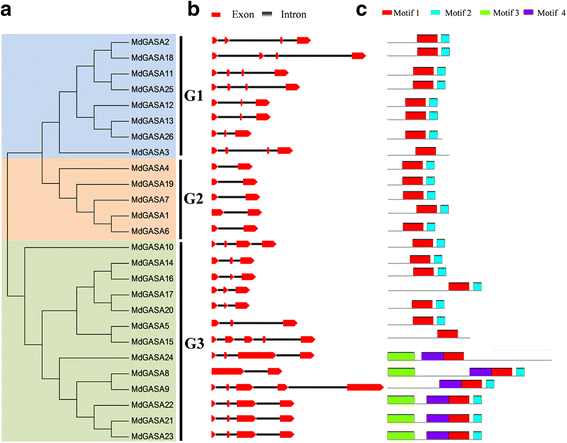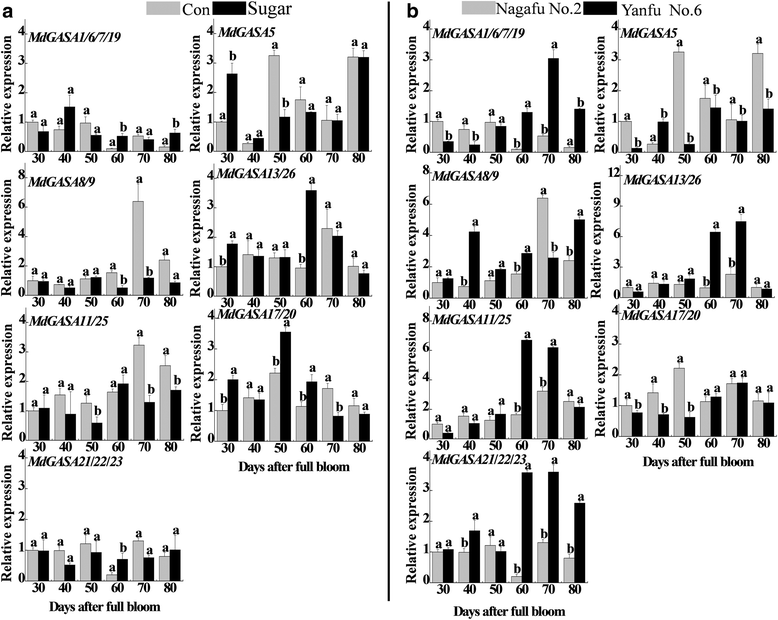Comprehensive analysis of GASA family members in the Malus domestica genome: identification, characterization, and their expressions in response to apple flower induction
- PMID: 29078754
- PMCID: PMC5658915
- DOI: 10.1186/s12864-017-4213-5
Comprehensive analysis of GASA family members in the Malus domestica genome: identification, characterization, and their expressions in response to apple flower induction
Abstract
Background: The plant-specific gibberellic acid stimulated Arabidopsis (GASA) gene family is critical for plant development. However, little is known about these genes, particularly in fruit tree species.
Results: We identified 15 putative Arabidopsis thaliana GASA (AtGASA) and 26 apple GASA (MdGASA) genes. The identified genes were then characterized (e.g., chromosomal location, structure, and evolutionary relationships). All of the identified A. thaliana and apple GASA proteins included a conserved GASA domain and exhibited similar characteristics. Specifically, the MdGASA expression levels in various tissues and organs were analyzed based on an online gene expression profile and by qRT-PCR. These genes were more highly expressed in the leaves, buds, and fruits compared with the seeds, roots, and seedlings. MdGASA genes were also responsive to gibberellic acid (GA3) and abscisic acid treatments. Additionally, transcriptome sequencing results revealed seven potential flowering-related MdGASA genes. We analyzed the expression levels of these genes in response to flowering-related treatments (GA3, 6-benzylaminopurine, and sugar) and in apple varieties that differed in terms of flowering ('Nagafu No. 2' and 'Yanfu No. 6') during the flower induction period. These candidate MdGASA genes exhibited diverse expression patterns. The expression levels of six MdGASA genes were inhibited by GA3, while the expression of one gene was up-regulated. Additionally, there were expression-level differences induced by the 6-benzylaminopurine and sugar treatments during the flower induction stage, as well as in the different flowering varieties.
Conclusion: This study represents the first comprehensive investigation of the A. thaliana and apple GASA gene families. Our data may provide useful clues for future studies and may support the hypotheses regarding the role of GASA proteins during the flower induction stage in fruit tree species.
Keywords: Apple; Characterization; Expression profile; Flower induction; GASA gene.
Conflict of interest statement
Ethics approval and consent to participate
Consent for publication
Not applicable.
Competing interests
The authors declare that they have no competing interests.
Publisher’s Note
Springer Nature remains neutral with regard to jurisdictional claims in published maps and institutional affiliations.
Figures











Similar articles
-
Phylogenetic analysis of IDD gene family and characterization of its expression in response to flower induction in Malus.Mol Genet Genomics. 2017 Aug;292(4):755-771. doi: 10.1007/s00438-017-1306-4. Epub 2017 Mar 17. Mol Genet Genomics. 2017. PMID: 28314937
-
A genome-wide approach to the comprehensive analysis of GASA gene family in Glycine max.Plant Mol Biol. 2019 Aug;100(6):607-620. doi: 10.1007/s11103-019-00883-1. Epub 2019 May 23. Plant Mol Biol. 2019. PMID: 31123969
-
Genome-wide identification and analysis of the SBP-box family genes in apple (Malus × domestica Borkh.).Plant Physiol Biochem. 2013 Sep;70:100-14. doi: 10.1016/j.plaphy.2013.05.021. Epub 2013 May 25. Plant Physiol Biochem. 2013. PMID: 23771035
-
Insights into flowering mechanisms in apple (Malus × domestica Borkh.) amidst climate change: An exploration of genetic and epigenetic factors.Biochim Biophys Acta Gen Subj. 2024 May;1868(5):130593. doi: 10.1016/j.bbagen.2024.130593. Epub 2024 Feb 24. Biochim Biophys Acta Gen Subj. 2024. PMID: 38408683 Review.
-
Quantifying key parameters as elicitors for alternate fruit bearing in cv. 'Elstar' apple trees.Plant Sci. 2013 Nov;212:10-4. doi: 10.1016/j.plantsci.2013.07.009. Epub 2013 Aug 3. Plant Sci. 2013. PMID: 24094049 Review.
Cited by
-
The Stylo Cysteine-Rich Peptide SgSnakin1 Is Involved in Aluminum Tolerance through Enhancing Reactive Oxygen Species Scavenging.Int J Mol Sci. 2024 Jun 18;25(12):6672. doi: 10.3390/ijms25126672. Int J Mol Sci. 2024. PMID: 38928379 Free PMC article.
-
Molecular and Biological Properties of Snakins: The Foremost Cysteine-Rich Plant Host Defense Peptides.J Fungi (Basel). 2020 Oct 12;6(4):220. doi: 10.3390/jof6040220. J Fungi (Basel). 2020. PMID: 33053707 Free PMC article. Review.
-
Identification and Analysis of the GASR Gene Family in Common Wheat (Triticum aestivum L.) and Characterization of TaGASR34, a Gene Associated With Seed Dormancy and Germination.Front Genet. 2019 Oct 18;10:980. doi: 10.3389/fgene.2019.00980. eCollection 2019. Front Genet. 2019. PMID: 31681420 Free PMC article.
-
GhGASA14 regulates the flowering time of upland cotton in response to GA3.Plant Cell Rep. 2024 Jun 13;43(7):170. doi: 10.1007/s00299-024-03252-5. Plant Cell Rep. 2024. PMID: 38869848
-
Investigation and Computational Analysis of the Sulfotransferase (SOT) Gene Family in Potato (Solanum tuberosum): Insights into Sulfur Adjustment for Proper Development and Stimuli Responses.Plants (Basel). 2021 Nov 26;10(12):2597. doi: 10.3390/plants10122597. Plants (Basel). 2021. PMID: 34961068 Free PMC article.
References
-
- Shi LF, Gast RT, Gopalraj M, Olszewski NE. Characterization of a shoot-specific, Ga3-regulated and Aba-regulated gene from tomato. Plant J. 1992;2(2):153–159. - PubMed
-
- Nahirnak V, Rivarola M, de Urreta MG, Paniego N, Hopp HE, Almasia NI, Vazquez-Rovere C. Genome-wide analysis of the Snakin/GASA gene family in Solanum Tuberosum cv. Kennebec. Am J Potato Res. 2016;93(2):172–188. doi: 10.1007/s12230-016-9494-8. - DOI
MeSH terms
Substances
LinkOut - more resources
Full Text Sources
Other Literature Sources
Molecular Biology Databases

